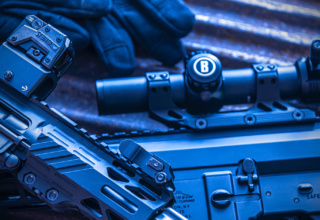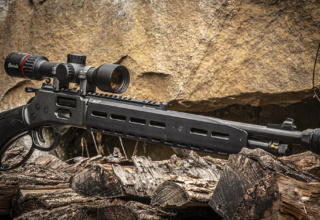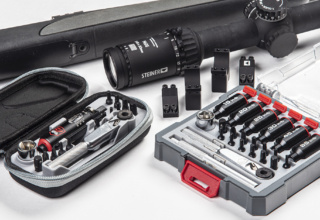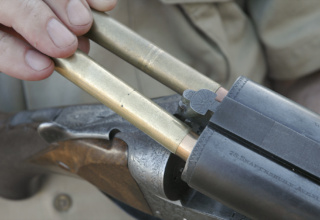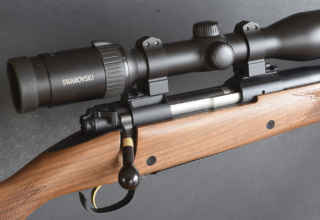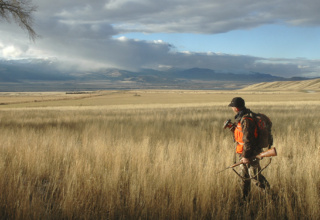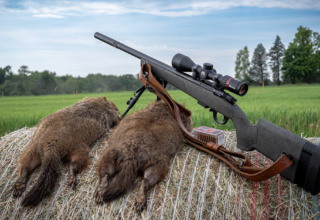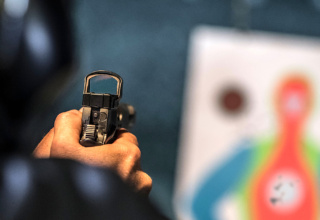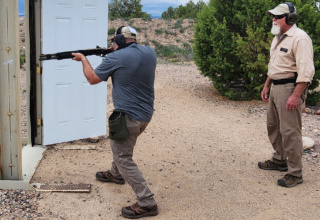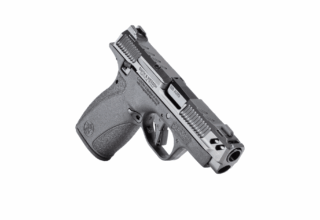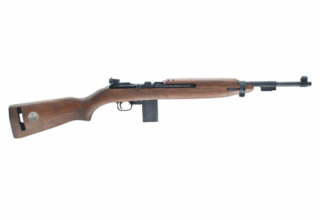Numbers, acronyms, and hyperbole don’t help you hit. Here’s what does.
by Wayne van Zwoll
I don’t recall seeing the bead when the whitetail tumbled through the aspens with a broken neck, or the crosswire when the bear skidded into the alders. The dot was barely visible when, in timber at dusk, the elk collapsed.
Your pick of sights matters not if you’re blessed with less urgent shots in better light. But guiding hunters and on my own, I’ve seen few mature animals offer themselves up in statuesque pose for studied execution.
A moment of truth can be brief. Then the sight is reduced to a fixed image your eye marries to the target. Iron or optic, its cost, origins, features, and adjustments are moot.

Woe to the hunter who tends his sight when it’s time to aim! After I spied a big mule deer below us in the sage, a friend fiddled frantically with his scope’s power ring, trying to find the beast. It waltzed out of sight. An elk hunter eased over a ridge after a stalk to find six bulls spread as if on a banquet table in a meadow at our feet. In his high-power scope, he caught aim at none of them as they trotted off.
On some rifles, any optic is an abomination. Yes, iron sights have become fuzzy. My teeth have lost sparkle too; but I still smile.

Whatever the sight, it must come to eye as you cheek the rifle. Low over-bore is best. You should not have to crane your neck to aim. A scope must also be far enough in front of your eye that you needn’t pull your head back to see a full field. Throwing a rifle up for a fast shot offhand or going prone for a long poke, you naturally slide your head ahead on the comb, closer to the sight than when you stood upright in your den installing it.
In favorable light, the unaided eye can distinguish about a minute of angle (an inch at 100 yards). Prone with a sling on a hunting rifle, I work hard to hold inside 1 ½ MOA. Pulse and wobble from the sit easily double that. Offhand, sight movement can sweep a man-hole cover.

Optics can’t help you hold rifles steadier than you can hold iron-sighted rifles. Hunters weaned on irons have proven deadly on game out to 200 yards or so—as far as most game is killed, and farther than I’ll take an offhand shot using a scope.
For hunting, a gold or ivory front bead is hard to beat. While snow hides ivory, aspen leaves can steal your gold. Both sights beg cleaning. When ivory beads were real ivory, hunters freshened them with a wash of grain alcohol and sunlight. A clean-edged black blade excels in bullseye competition but fades in shadow and lets your eye wander vertically. Fluorescent sights leap to eye but bounce light that blurs detail on their hem and, in effect, adds to their already large diameter.

A bead should be concave or flat-faced and slightly angled up to catch skylight. A convex bead reflects light to the sun, so you aim with a false center and can miss by almost half the sight’s subtension. A zero that sends bullets to the top of a bead at 100 yards brings them near bead’s center from 150 to 180.
The best bead size depends on use and barrel length. In cover on big animals, a 3/32 bead makes sense, even on short barrels. For more precise aim on lesser game, 1/16-inch beads are better. In colonial India and Africa, double rifles for royalty had a small silver bead for day-time shooting, a bigger flip-up ivory bead for night.

A barrel-mounted notch is the simplest rear sight, and predated apertures. But by the 18th century, clever lads had adjustable aperture sights. On the tangs of single-shot and lever rifles, they aided buffalo hunters. Depression-era Springfield sporters wore aperture sights on cocking pieces. Most “peep” sights now are receiver-mounted. You can see a big field and get precise aim with a tiny aperture up close. Tight to my brow, pin-hole apertures carried me through Olympic tryouts and yielded dime-size knots in 50-meter prone matches. Hard-kicking hunting rifles beg bigger apertures and more eye relief.

An aperture trumps mid-barrel open sights. It doesn’t require your focus. Its rim can blur as your eye naturally seeks its center. Hunting, I like aperture diameter to match rim thickness at about 1/8-inch, depending on eye relief. “Ghost ring” apertures are enormous, with thin rims. Very fast. I got that effect by removing the disk on a Redfield sight to aim through the threaded hole.

Barrel-mounted open sights require your eye to focus on rear sight, front sight, and target at once. Impossible. Best you can do is focus on the bead, accept less-than-crisp images fore and aft. Still, a proper open sight is quick and preferred for dangerous game up close. I like a shallow V for clear view around the bead. It should be a single, fixed blade. Recoil or the swipe of a limb can flip multiple folding leaves, imposing a gross change of zero.
Hunters who don’t look down their noses at iron sights can be discouraged giving them a try. The problem is usually the target. It must be big enough to see easily around the bead. At 100 yards a 20-inch bullseye isn’t too big! With such targets, it’s no trick to drill 3-MOA groups from a bench or prone.

Oddly enough, when you must aim fast, a scope excels because it puts reticle and target in one plane. Magnification helps you kill out yonder, but only if yonder isn’t farther than you can send 9 of 10 shots inside the vitals. Up close, magnification can handicap you.

Grancel Fitz, who hunted all North America’s big game from the 1930s into the ’50s, killed some with iron sights on his .30-06 G&H Springfield, but also used a Hensoldt 2.75x scope. My first scope, in the 1960s, was a 2.5x. These sights had long, non-critical eye relief. You saw a full field fast with your eye 3 to 5 inches behind the ocular. Some of these scopes could be installed in front of flag safeties!

Most of a century later, 2.5x or 3x magnification still appeals to me. It’s power enough to help you tell limb from antler and find a shot alley through cover and nix the distraction of the front sight. But it’s not too strong. You get a big, bright field of view in a lightweight tube of modest front diameter. Your shakes are visible but manageable. You can follow moving game easily. Hunting, I keep variables at 2.5x or 3x. A .375 scoped at 3x took a leopard in tall grass at 11 paces and landed two bullets an inch apart in the shoulder of an eland at 220 yards. Only twice have I felt the need to dial past 4x.
I pair that low magnification with a simple “plex” reticle and check zero from prone with a sling.

A 1.5-5x, 2-7x, 2.5-8x or trim 3-9x scope, mounted low and the dial taped at 3x, is all you need to get game. Because at the moment of truth, it is iron-sight-quick and easy to use. Paste reticle on rib as you would a bead and squeeze.


